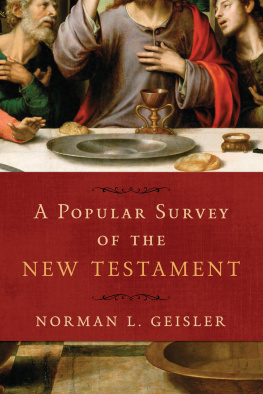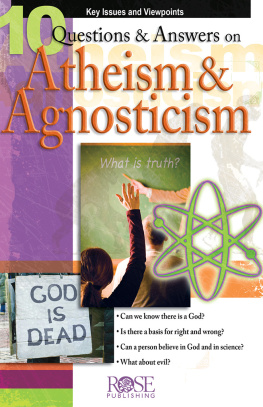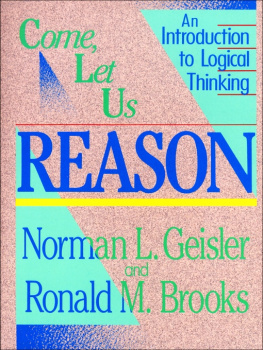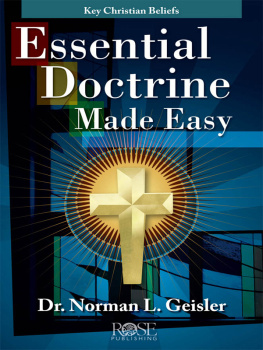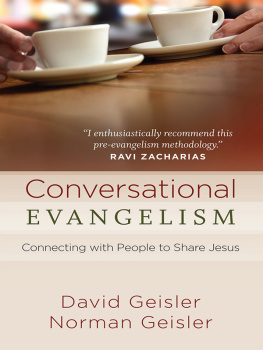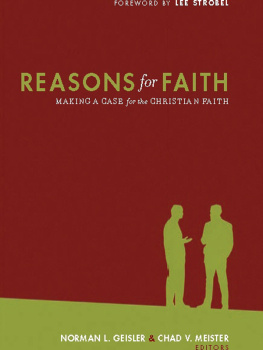Norman L. Geisler - A Popular Survey of the New Testament
Here you can read online Norman L. Geisler - A Popular Survey of the New Testament full text of the book (entire story) in english for free. Download pdf and epub, get meaning, cover and reviews about this ebook. year: 2014, publisher: Baker Publishing Group, genre: Religion. Description of the work, (preface) as well as reviews are available. Best literature library LitArk.com created for fans of good reading and offers a wide selection of genres:
Romance novel
Science fiction
Adventure
Detective
Science
History
Home and family
Prose
Art
Politics
Computer
Non-fiction
Religion
Business
Children
Humor
Choose a favorite category and find really read worthwhile books. Enjoy immersion in the world of imagination, feel the emotions of the characters or learn something new for yourself, make an fascinating discovery.
- Book:A Popular Survey of the New Testament
- Author:
- Publisher:Baker Publishing Group
- Genre:
- Year:2014
- Rating:5 / 5
- Favourites:Add to favourites
- Your mark:
- 100
- 1
- 2
- 3
- 4
- 5
A Popular Survey of the New Testament: summary, description and annotation
We offer to read an annotation, description, summary or preface (depends on what the author of the book "A Popular Survey of the New Testament" wrote himself). If you haven't found the necessary information about the book — write in the comments, we will try to find it.
A Popular Survey of the New Testament — read online for free the complete book (whole text) full work
Below is the text of the book, divided by pages. System saving the place of the last page read, allows you to conveniently read the book "A Popular Survey of the New Testament" online for free, without having to search again every time where you left off. Put a bookmark, and you can go to the page where you finished reading at any time.
Font size:
Interval:
Bookmark:
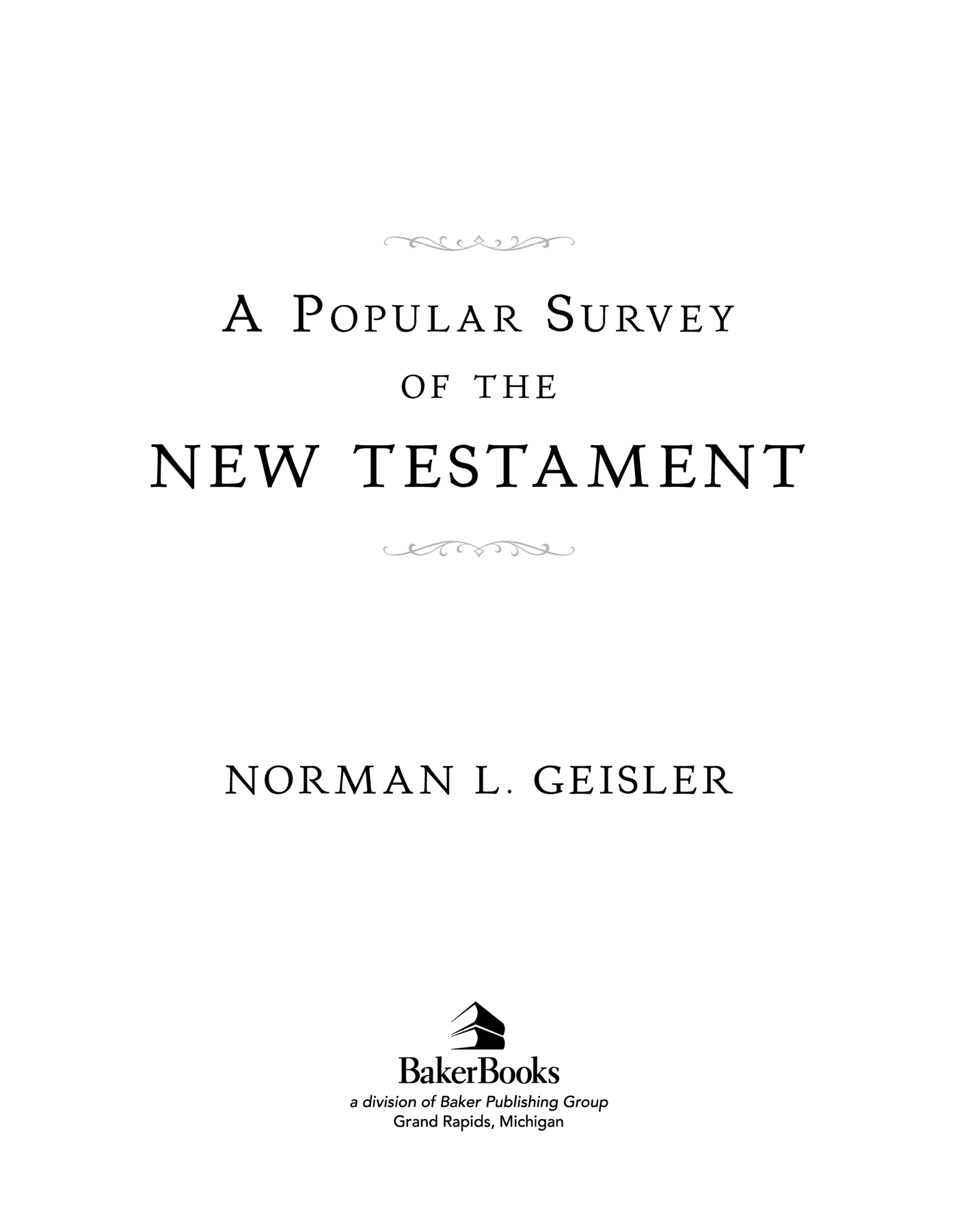
2007 by Norman L. Geisler
Published by Baker Books
a division of Baker Publishing Group
P.O. Box 6287, Grand Rapids, MI 49516-6287
www.bakerbooks.com
Ebook edition created 2014
Ebook corrections 02.24.2016, 06.27.2017, 07.29.2020
All rights reserved. No part of this publication may be reproduced, stored in a retrieval system, or transmitted in any form or by any meansfor example, electronic, photocopy, recordingwithout the prior written permission of the publisher. The only exception is brief quotations in printed reviews.
Library of Congress Cataloging-in-Publication Data is on file at the Library of Congress, Washington, DC.
ISBN 978-1-4412-2112-4
Unless otherwise noted, Scripture is taken from the New King James Version. Copyright 1982 by Thomas Nelson, Inc. Used by permission. All rights reserved.
Scripture marked KJV is taken from the King James Version of the Bible.
Scripture marked NASB is taken from the New American Standard Bible, copyright 1960, 1962, 1963, 1968, 1971, 1972, 1973, 1975, 1977, 1995 by The Lockman Foundation. Used by permission.
Scripture marked NIV is taken from the Holy Bible, New International Version. NIV. Copyright 1973, 1978, 1984 by Biblica, Inc. Used by permission of Zondervan. All rights reserved worldwide. www.zondervan.com
Material in How to Respond to Critics sections is taken largely from Norman L. Geisler and Thomas Howe, When Critics Ask: A Popular Handbook on Bible Difficulties , Baker Books, a division of Baker Publishing Group, 1997. Used with permission of the authors and the publisher.
Cover
Title Page
Copyright Page
Figures
1. A Christ-Centered Introduction to the Bible
2. The Gospel RecordHistory or Mythology?
3. Introduction to the Gospels
4. The Gospel of Matthew
5. The Gospel of Mark
6. The Gospel of Luke
7. The Gospel of John
8. The Book of Acts
9. Introduction to the Epistles
10. Romans
11. 1 Corinthians
12. 2 Corinthians
13. Galatians
14. Ephesians
15. Philippians
16. Colossians and Philemon
17. 1 Thessalonians
18. 2 Thessalonians
19. 1 Timothy
21. 2 Timothy
22. Hebrews
23. James
24. 1 Peter
25. 2 Peter
26. 1 John
27. 2 John, 3 John, and Jude
28. Revelation
Acknowledgments
Appendix 1: Early Church Fathers and Sources
Appendix 2: Early Citations of the New Testament
Appendix 3: Key Words and Phrases in the New Testament
Appendix 4: Miracles in the Gospels
Bibliography
Notes
About the Author
Back Ads
Back Cover
Figure 1.1 Biblical Bookshelf
Figure 2.1 Reliability of the New Testament Documents
Figure 2.2 Early Citations of the New Testament
Figure 3.1 One-Source Theory
Figure 3.2 Two-Document Theory
Figure 3.3 Mutual-Use Theory
Figure 3.4 Four-Document Theory
Figure 3.5 Fragment Theory
Figure 3.6 Oral Tradition Theory
Figure 3.7 Form Criticism Theory
Figure 3.8 Independent Eyewitness Records Theory
Figure 6.1 Matthew and Luke Genealogies Compared
1 Corinthians

First Corinthians is one of the least disputed books of Paul in the New Testament. Along with 2 Corinthians, Romans, and Galatians, it has Pauls fingerprints all over it. It is also one of the early books in the New Testament and provides an insightful portrait of a cosmopolitan, worldly, and struggling New Testament church.
Who Wrote It?
The evidence that the apostle Paul wrote this book is beyond all reasonable doubt. This is clear from the book itself as well as from early and later sources outside 1 Corinthians that cite it.
Internal Evidence
The book begins with the claim that Paul, called to be an apostle, wrote it (1:1). This claim is repeated throughout the book (1:1214; 3:45, 22; 16:21). Further, the character of the book is Pauline. Not only is it in his writing style, but it manifests his doctrinal interest as well as his pastoral care for the church. Even the critics of the book are virtually unanimous in supporting the Pauline authorship. Typically, he signs off with a greeting in his own hand (16:21; see 2 Thess. 3:17).
External Evidence
The evidence from outside the book supports strongly the internal evidence. First of all, Pauls name is found on it in the earliest known manuscripts of the book. Further, the earliest Fathers, beginning in apostolic times (with Clement of Rome, ca. AD 95), attributed it to Paul. From the first century on, there is a continuous and nearly unanimous consent of Fathers and later scholars who cite it. This includes Ignatius, Polycarp, Shepherd of Hermas , the Didache, Irenaeus, Justin Martyr, Clement of Alexandria, Tertullian, Origen, Cyril of Jerusalem, Eusebius, Jerome, and Augustine.
When Was It Written?
The book was written between AD 55 and 56, while Paul was at Ephesus (Acts 19:1). The evidence in support of this date comes from several internal and external facts combined. First of all, we know from secular sources that the proconsul Gallio began his term in AD 51 (18:12). Further, according to Acts 18, Paul ministered in Corinth there in AD 50 to 51. And Paul was in Ephesus for more than two years (19:10). It was during this time that he wrote 1 Corinthians. This would place it about AD 55 to 56.
To Whom Was It Written?
The book of 1 Corinthians was written to the pagan converts of Corinth called the church of God, which is at Corinth, to those who are sanctified in Christ Jesus, called to be saints (1:2).
There were some one-half million people in Corinth. It was known as the vanity fair of the Roman Empire. It was considered a city of vulgar materialism and immorality and a place of idolatry. The goddess Aphrodite was a favorite. Corinth was also a place of pleasure and sensuality, which had even penetrated the church and meant that one of its members should be excommunicated (5:1). The Christians were chiefly poor and pagan and not rich or Jewish.
Where Were the Readers Located?
The recipients of the letter were located in the city of Corinth in the province of Achaia (Europe). Corinth was an important center of commerce. It was a place of athletic contests, second only to Olympia (see the athletic metaphor in 1 Cor. 9:2427). It was also an international city with a mixed population. Although it was Greek, it boasted no great philosophers as Athens had. Indeed, Paul chided the church for the lack of many wise people in their number (see 1:20).
Why Was It Written?
There were many reasons for the writing of this Epistle. They can be divided according to corresponding chapters. (1) Paul was concerned about administering the churchs affairs (chaps. 16). (2) He desired to answer the churchs questions (chaps. 714). (3) Paul wanted to address the churchs misgivings (chap. 15). (4) He wished to ask for the churchs contribution to help the poor saints in Jerusalem (chap. 16).
What Is It About?
The Theme: Sanctification in Christ (1:2).
The Key Verse: The key verse is 2:14: The natural man does not receive the things of the Spirit of God, for they are foolishness to him; nor can he know them, because they are spiritually discerned.
Key Words and Phrases: body (44x), brethren (38x), church (22x), cross (2x), crucify (4x), discern , examine , judge (10x), exercise authority , authority (13x), holy , saints (13x), know (48x), power (15x), raise , raise up , resurrection (20x), sanctif y (4x), Spirit (41x), spiritual , spiritually (15x), unbelievers (11x), wisdom , wise (26x), world (21x), you , your (150x). See appendix 3 for a more complete word study.
Font size:
Interval:
Bookmark:
Similar books «A Popular Survey of the New Testament»
Look at similar books to A Popular Survey of the New Testament. We have selected literature similar in name and meaning in the hope of providing readers with more options to find new, interesting, not yet read works.
Discussion, reviews of the book A Popular Survey of the New Testament and just readers' own opinions. Leave your comments, write what you think about the work, its meaning or the main characters. Specify what exactly you liked and what you didn't like, and why you think so.

